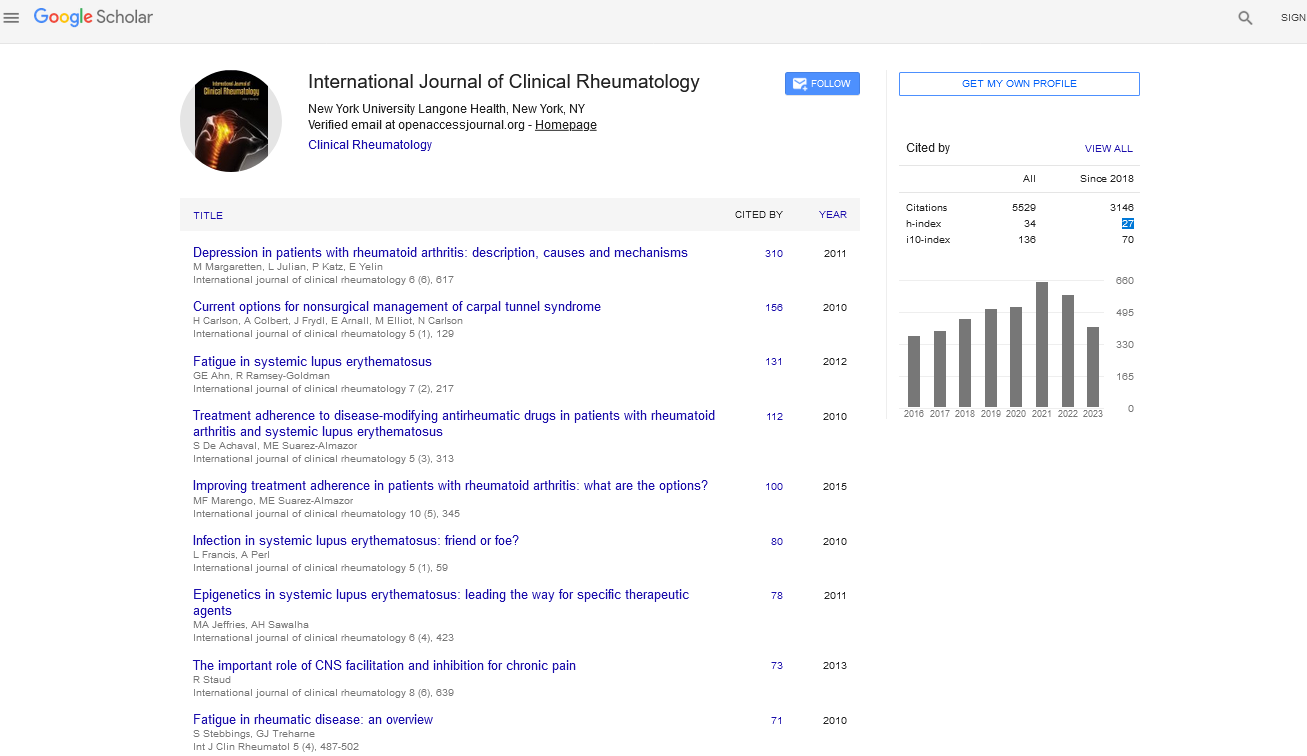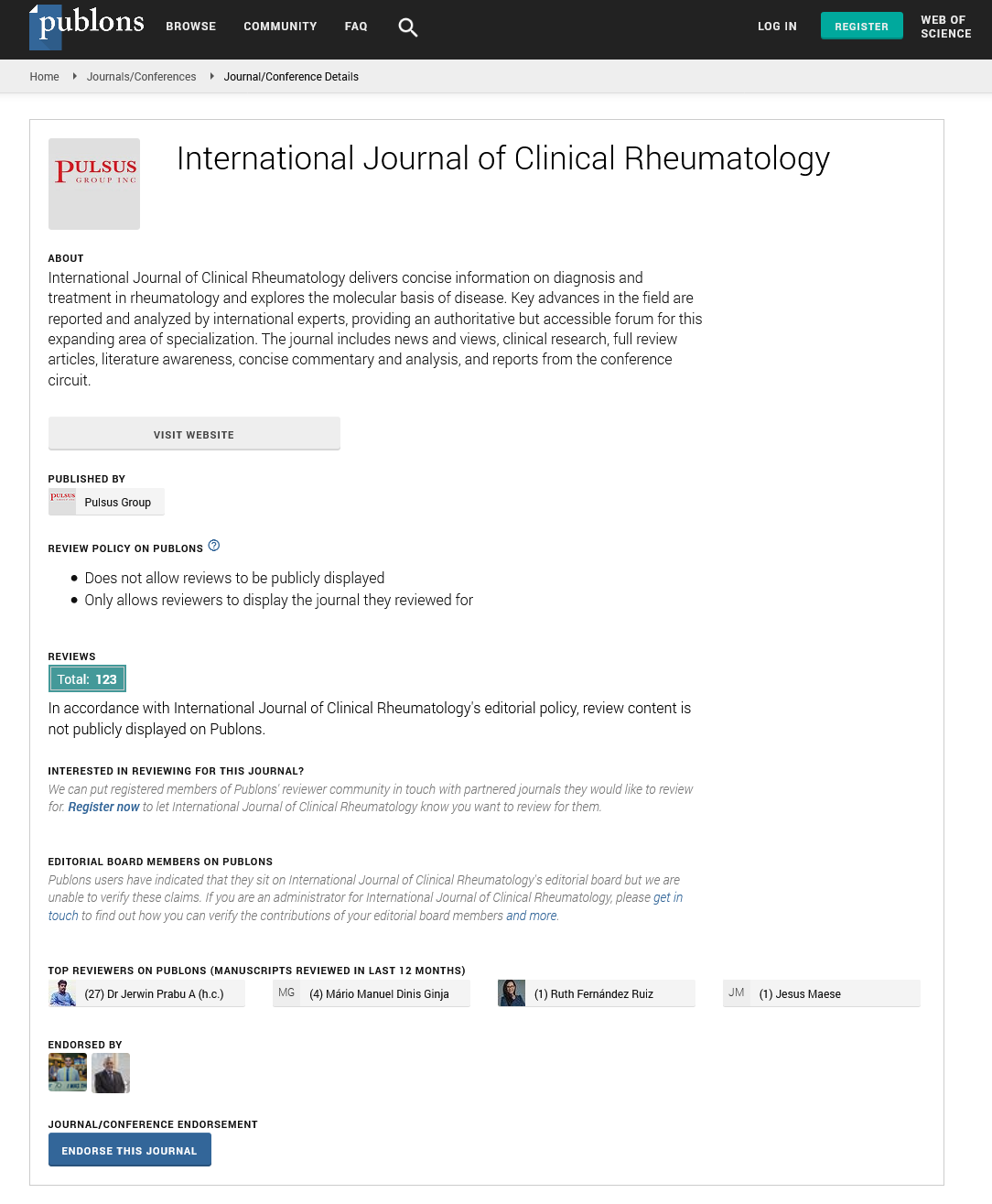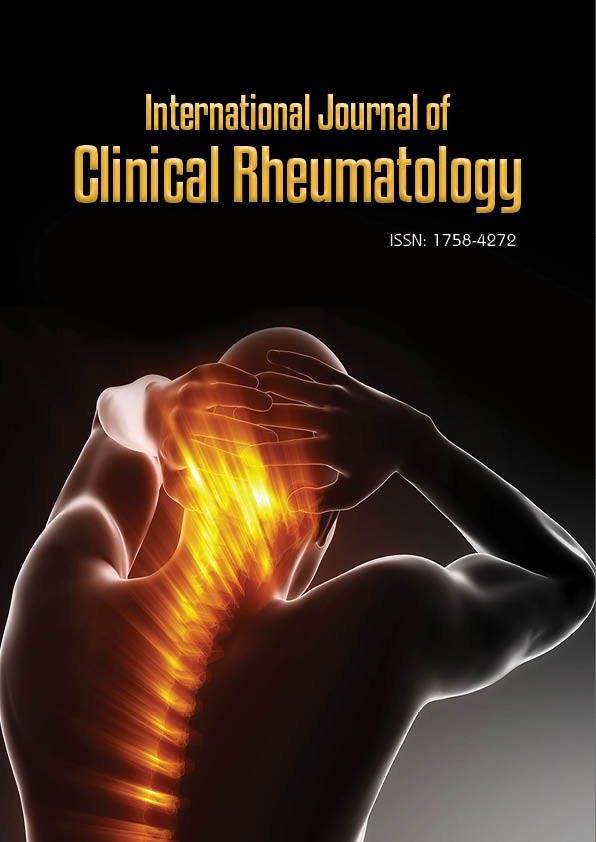Short Communication - International Journal of Clinical Rheumatology (2024) Volume 19, Issue 7
Juvenile Idiopathic Arthritis: Understanding, Diagnosis, and Management
James Anderson*
Department of Applied Biological Chemistry, Graduate School of Rheumatologic and Life Sciences, University of Ghutania, Japan
- *Corresponding Author:
- James Anderson
Department of Applied Biological Chemistry, Graduate School of Rheumatologic and Life Sciences, University of Ghutania, Japan
E-mail: james.anderson@yahoo.com
Received: 01-Jul-2024, Manuscript No. fmijcr-24-150648; Editor assigned: 03- Jul-2024, Pre-QC No. fmijcr-24-150648 (PQ); Reviewed: 16-Jul-2024, QC No. fmijcr-24-150648; Revised: 22- Jul-2024, Manuscript No. fmijcr-24-150648 (R); Published: 29- Jul-2024, DOI: 10.37532/1758- 4272.2024.19(7).230-232
Abstract
Juvenile Idiopathic Arthritis (JIA) is a chronic autoimmune disorder that leads to joint inflammation in children and adolescents, impacting their daily lives and development. This article offers a comprehensive overview of JIA, detailing its symptoms, potential causes, diagnostic methods, and treatment options. Although the exact cause of JIA remains unknown, early detection and timely intervention are vital for effectively managing the condition and preventing long-term complications. Treatment approaches primarily aim to reduce inflammation, alleviate pain, and enhance joint function, employing a combination of medications, physical therapy, and occupational therapy tailored to each patient's needs. Increasing awareness and ongoing research are essential for advancing the understanding of JIA, ultimately aiming to improve the quality of life for those affected. By shedding light on the challenges faced by children with JIA and the importance of a multidisciplinary approach to care, this article hopes to foster informed discussions among healthcare providers, patients, and families about effective management strategies and the latest developments in research.
Juvenile idiopathic arthritis (JIA) â Pediatric rheumatology
Introduction
Juvenile Idiopathic Arthritis (JIA) is a chronic autoimmune condition that affects children and adolescents, causing inflammation in the joints. Formerly known as Juvenile Rheumatoid Arthritis (JRA), JIA is characterized by joint pain, stiffness, and swelling, which can lead to long-term disability if left, untreated. Despite its name, JIA has no known cause, making it a challenging condition to diagnose and manage. Symptoms of JIA vary from mild to severe and can include joint pain, swelling, stiffness, and limited range of motion. Children with JIA may also experience fatigue, fever, and eye inflammation [1]. The disease can affect any joint in the body, including the knees, wrists, ankles, and fingers. In some cases, JIA can also affect internal organs such as the heart and lungs. The exact cause of JIA remains unknown, but it is believed to result from a combination of genetic and environmental factors. Certain genes may predispose individuals to developing JIA, while environmental triggers such as infections or trauma may contribute to the onset of symptoms. Diagnosing JIA involves a thorough physical examination, medical history review, and various tests, including blood tests, imaging studies, and joint fluid analysis [2], [3]. Early diagnosis and intervention are crucial in managing JIA and preventing long-term complications. Treatment for JIA aims to reduce inflammation, relieve pain, and improve joint function. Nonsteroidal anti-inflammatory drugs (NSAIDs) are often prescribed to alleviate symptoms. In more severe cases, disease-modifying antirheumatic drugs (DMARDs) or biologic agents may be recommended to suppress the immune system and prevent joint damage. Physical therapy and occupational therapy can also help improve joint mobility and strengthen muscles [4]. Living with JIA can be challenging for children and their families, but with proper management and support, many individuals with JIA can lead active and fulfilling lives. Regular medical follow-ups are essential to monitor disease activity, adjust treatment as needed, and address any complications that may arise. Juvenile Idiopathic Arthritis is a chronic autoimmune condition that affects children and adolescents, causing inflammation in the joints [5]. While the exact cause remains unknown, early diagnosis and comprehensive treatment can help manage symptoms and improve quality of life for those living with JIA. Increased awareness, research, and support are vital in advancing the understanding and treatment of this complex condition.
Discussion
Juvenile Idiopathic Arthritis (JIA) presents a complex challenge in pediatric rheumatology due to its heterogeneous nature and varying clinical manifestations. The discussion surrounding JIA encompasses several key points, including its etiology, diagnosis, treatment modalities, and long-term outcomes [6].
Etiology: Despite extensive research efforts, the exact etiology of JIA remains elusive. It is widely believed to result from a combination of genetic predisposition and environmental factors. Genetic studies have identified certain susceptibility genes associated with JIA, but environmental triggers such as infections or trauma may also play a role in triggering the autoimmune response [7].
Diagnosis: Diagnosing JIA requires a comprehensive evaluation, including a thorough medical history review, physical examination, and laboratory tests. The classification criteria for JIA have evolved over the years to encompass the various subtypes and clinical presentations of the disease. Differentiating JIA from other causes of childhood arthritis is crucial for initiating appropriate treatment and preventing disease progression.
Treatment modalities: The management of JIA aims to control inflammation, alleviate symptoms, and preserve joint function. Nonsteroidal anti-inflammatory drugs (NSAIDs) are often used as first-line therapy to relieve pain and reduce inflammation. Disease-modifying antirheumatic drugs (DMARDs) and biologic agents are reserved for cases of moderate to severe JIA or those resistant to conventional therapy. The introduction of biologic agents targeting specific cytokines or cell surface molecules has revolutionized the treatment of JIA, leading to improved outcomes and quality of life for many patients [8].
Long-term outcomes: While JIA can cause significant morbidity and disability if left untreated, early diagnosis and aggressive treatment have been shown to improve long-term outcomes. However, some patients may experience persistent disease activity despite treatment, leading to joint damage and functional impairment. Regular monitoring and adjustments to treatment are essential to optimize disease control and minimize the risk of complications.
Challenges and future directions: Despite advances in the understanding and management of JIA, several challenges remain. These include the need for better biomarkers to predict disease progression, the development of targeted therapies with fewer side effects, and strategies to address the psychosocial impact of JIA on patients and their families. Collaborative efforts among clinicians, researchers, and patient advocacy groups are essential to address these challenges and improve outcomes for individuals living with JIA. The discussion surrounding JIA highlights the complexity of this autoimmune disorder and the importance of a multidisciplinary approach to its diagnosis and management [9], [10]. Continued research and innovation are needed to further elucidate the underlying mechanisms of JIA and develop more effective therapies to improve the quality of life for affected individuals.
Conclusion
Juvenile Idiopathic Arthritis (JIA) is a chronic autoimmune condition that presents unique challenges in pediatric rheumatology. Despite the lack of a known cause, advancements in diagnostic criteria and treatment modalities have significantly improved outcomes for children and adolescents with JIA. Early diagnosis, aggressive treatment, and multidisciplinary care are essential in managing JIA and minimizing long-term disability. The availability of targeted therapies, such as biologic agents, has revolutionized the treatment landscape for JIA, offering improved disease control and quality of life for many patients. However, challenges remain, including the need for better biomarkers, personalized treatment approaches, and strategies to address the psychosocial impact of JIA on patients and their families. Overall, increased awareness, ongoing research, and collaborative efforts among clinicians, researchers, and patient advocacy groups are crucial in advancing the understanding and management of JIA. By working together, we can continue to make strides in improving outcomes and enhancing the lives of children and adolescents living with this complex autoimmune disorder.
References
- Pourakbari B, Mamishi S, Mashoori N, Mahboobi N, Ashtiani MH, Afsharpaiman S, et al. (2010) Frequency and antimicrobial susceptibility of Shigella species isolated in children medical center hospital, Tehran, Iran, 2001–2006. Braz J Infect Dis 14: 153–157.
- Nikfar R, Shamsizadeh A, Darbor M, Khaghani S, Moghaddam M. (2017) A Study of prevalence of Shigella species and antimicrobial resistance patterns in paediatric medical center, Ahvaz, Iran. Iran J Microbiol 9: 277.
- Kacmaz B, Unaldi O, Sultan N, Durmaz R (2014) Drug resistance profiles and clonality of sporadic Shigella sonnei isolates in Ankara, Turkey. Braz J Microbiol 45: 845–849.
- Akcali A, Levent B, AkbaÅ E, Esen B (2008) Typing of Shigella sonnei strains isolated in some provinces of Turkey using antimicrobial resistance and pulsed field gel electrophoresis methods. Mikrobiyol Bul 42: 563–572.
- Jafari F, Hamidian M, Rezadehbashi M, Doyle M, Salmanzadeh-Ahrabi S, et al. (2009) Prevalence and antimicrobial resistance of diarrheagenic Escherichia coli and Shigella species associated with acute diarrhea in Tehran, Iran. Can J Infect Dis Med Microbiol 20: 56–62.
- Ranjbar R, Behnood V, Memariani H, Najafi A, Moghbeli M, et al. (2016) Molecular characterisation of quinolone-resistant Shigella strains isolated in Tehran, Iran. J Glob Antimicrob Resist 5: 26–30.
- Zamanlou S, Ahangarzadeh Rezaee M, Aghazadeh M, Ghotaslou R, et al. (2018) Characterization of integrons, extended-spectrum β-lactamases, AmpC cephalosporinase, quinolone resistance, and molecular typing of Shigella spp. Infect Dis 50: 616–624.
- Varghese S, Aggarwal A (2011) Extended spectrum beta-lactamase production in Shigella isolates-A matter of concern. Indian J Med Microbiol 29: 76.
- Peirano G, Agersø Y, Aarestrup FM, Dos Prazeres Rodrigues D (2005) Occurrence of integrons and resistance genes among sulphonamide-resistant Shigella spp. from Brazil. J Antimicrob Chemother 55: 301–305.
- Kang HY, Jeong YS, Oh JY, Tae SH, Choi CH, et al. (2005) Characterization of antimicrobial resistance and class 1 integrons found in Escherichia coli isolates from humans and animals in Korea. J Antimicrob Chemother 55: 639-644.
Indexed at, Google Scholar, Crossref
Indexed at, Google Scholar, Crossref
Indexed at, Google Scholar, Crossref
Indexed at, Google Scholar, Crossref
Indexed at, Google Scholar, Crossref
Indexed at, Google Scholar, Crossref
Indexed at, Google Scholar, Crossref


